Male Breast Reduction (Gynecomastia Surgery) in Washington, DC
Restore Confidence with Gynecomastia Surgery
Gynecomastia is a medical term that comes from the Greek words for women-like breasts. Though this oddly named condition is rarely talked about, it is actually quite common. Gynecomastia affects an estimated 40 to 60 percent of men. It may affect only one breast or both. Though certain drugs and medical problems have been linked with male breast overdevelopment, there is no known cause in the vast majority of cases.
Who Is a Good Candidate for Male Breast Reduction?
For men who feel self-conscious about their appearance, breast-reduction surgery can help. The procedure removes fat and or glandular tissue from the breasts, and in extreme cases removes excess skin, resulting in a chest that is flatter, firmer, and better contoured. Gynecomastia surgery is a highly individualized procedure and you should do it for yourself, not to fulfill someone else’s desires or to try to fit any sort of ideal image. This procedure is a good option for you if:
- You are physically healthy and of relatively normal weight
- You have realistic expectations
- Your breast development has stabilized
- You are bothered by the feeling that your breasts are too large
Gynecomastia Evaluation Process
The initial consultation with Dr. Baker is very important. He will need a complete medical history, so check your own records ahead of time and be ready to provide this information. If a medical problem is the suspected cause, you will be referred to an appropriate specialist.
Dr. Baker will evaluate the degree of ptosis associated with your condition and discuss the options that would best meet your goals. Frequently in gynecomastia repair, there are multiple approaches to perform the correction. Each approach has its associated advantages and disadvantages, and Dr. Baker will review all of these with you.
Do not hesitate to ask Dr. Baker any questions you may have during the initial consultation- including your concerns about the recommended treatment or the costs involved. Treatment of gynecomastia may be covered by medical insurance, but policies vary. Check with your health insurance provider to be sure.
What is Gynecomastia Surgery?
Plastic surgery to correct gynecomastia is technically called reduction mammaplasty, and reduces breast size, flattening and enhancing the chest contours. In severe cases of gynecomastia, the weight of excess breast tissue may cause the breasts to sag and stretch the areola (the dark skin surrounding the nipple). In these cases the position and size of the areola can be surgically improved and excess skin may be reduced. Most patients can achieve a successful result with a small incision at the border of the areola from the 3 o’clock position to the 9 o’ clock position. In patients with a more pronounced breast, the incisions may need to be longer to remove redundant skin in addition to the glandular tissue.
Liposuction for Gynecomastia
In cases where gynecomastia is primarily the result of excess fatty tissue, liposuction techniques alone may be used. This requires insertion of a cannula, a thin hollow tube, through several small incisions. The cannula is moved back and forth in a controlled motion to loosen the excess fat, which is then removed from the body by vacuum suction. There are various liposuction techniques that may be used; the technique most appropriate in your case will be defined prior to your procedure.
Excision Technique
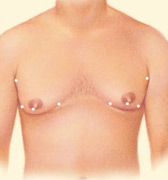
In cases where gynecomastia is primarily the result of excess fatty tissue, liposuction techniques alone may be used.

After liposuction, the patient has a flatter chest contour.
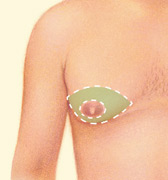
Excision techniques are recommended when glandular breast tissue or excess skin must be removed.
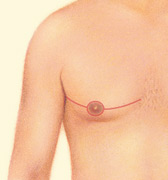
Incision patterns vary depending on the specific conditions and the surgeon’s preference.
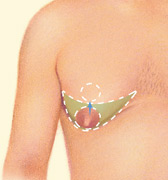
Sometimes a combined approach with both excision and liposuction is necessary.
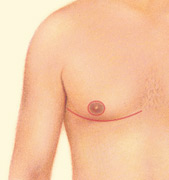
Excision techniques are recommended where glandular breast tissue or excess skin must be removed to correct gynecomastia. Excision also is necessary if the areola will be reduced, or the nipple repositioned to a more natural male contour. Incision patterns vary depending on the specific conditions and surgical preference.
Will There Be Scars?
Any surgical treatment to correct gynecomastia will require incisions. While most incision lines are concealed within natural contours, some may be visible and are a necessary result of breast reduction surgery.
Anesthesia for Gynecomastia Surgery
Medications are administered for your comfort during the surgical procedure. The choices include intravenous sedation and general anesthesia. Dr. Baker will recommend the best choice for you.
Gynecomastia Surgery Risks and Complications
When male breast-reduction surgery is performed by a qualified plastic surgeon, complications are infrequent and usually minor. Nevertheless, as with any surgery, there are risks. These include infection, skin injury, excessive bleeding, adverse reaction to anesthesia, and excessive fluid loss or accumulation. The procedure may also result in noticeable scars, permanent pigment changes in the breast area, or slightly mismatched breasts or nipples. If asymmetry is significant, a second procedure may be performed to remove additional tissue. The temporary side effects of male breast reduction include loss of breast sensation or numbness, which may last up to a year.
Gynecomastia Surgery Recovery Timeline
Whether you have had excision with a scalpel or liposuction, you will feel some discomfort for a few days after surgery. However, discomfort can be controlled with medications prescribed by Dr. Baker. In any case, you should arrange to have someone drive you home after surgery and to help you out for a day or two if needed.
You will be swollen and bruised for a while. In fact, you may wonder if there has been any improvement at all. To help reduce swelling, you will be instructed to wear an elastic pressure garment continuously for a week or two, and for a few weeks longer at night. Although the worst of your swelling will dissipate in the first few weeks, it may be three months or more before the final results of your surgery are apparent.
In the meantime, it is important to begin getting back to normal. You will be encouraged to begin walking around on the day of surgery, and can return to work when you feel well enough–which could be as early as a day or two after surgery. Any stitches will generally be removed about 1 to 2 weeks following the procedure.
Dr. Baker advises to refrain from sexual activity for a week or two, and heavy exercise for about three weeks. You will be told to stay away from any sport or job that risks a blow to the chest area for at least four weeks. In general, it will take about a month before you are back to all of your normal activities.
You should also avoid exposing the resulting scars to the sun for at least six months. Sunlight can permanently affect the skin’s pigmentation, causing the scar to turn dark. If sun exposure is unavoidable, use a strong sunblock.
Results: What Will My Chest Look Like After Surgery?
Gynecomastia surgery can enhance your appearance and self-confidence, but it will not necessarily change your looks to match your ideal. Before you decide to have surgery, think carefully about your expectations and discuss them frankly with your plastic surgeon.
The results of the procedure are significant and permanent. If your expectations are realistic, chances are good that you will be very satisfied with your new look.
Schedule a Gynecomastia Consultation in Washington, DC
Interested in learning more about Gynecomastia surgery in Washington DC? Contact Our office to schedule your informative consultation with Dr. Stephen Baker. He will gladly answer any of the questions you have and guide you throughout the entire process.
As Featured In






